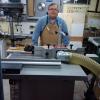And some tapes I have found will give you different readings from the top and bottom scale on the same tape!! A consistent tape is hard to find, and when you do, treat them gingerly. If I accidentally drop a tape... no matter what it is automatically replaced. I take a Starrett 12" rule with me when I want to buy a new tape for a base measure, both in push and pull with the end. It is the same ruler I use to set the base measure on my power tools too.
It is easier to be imperfect and plan for it, than to try to be perfect and swear at it.




 Reply With Quote
Reply With Quote




